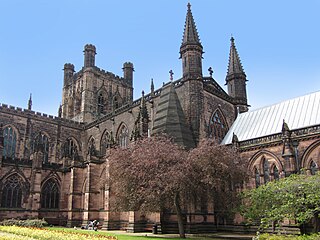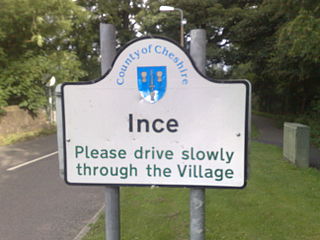
Chester is a cathedral city and the county town of Cheshire, England. It is located on the River Dee, close to the English–Welsh border. With a population of 79,645 in 2011, it is the most populous settlement of Cheshire West and Chester and serves as its administrative headquarters. It is also the historic county town of Cheshire and the second-largest settlement in Cheshire after Warrington.

Hugh d'Avranches, nicknamed le Gros or Lupus, was from 1071 the second Norman Earl of Chester and one of the great magnates of early Norman England.

Werburgh was an Anglo-Saxon princess who became the patron saint of the city of Chester in Cheshire. Her feast day is 3 February.
Ranulf Higden or Higdon was an English chronicler and a Benedictine monk who wrote the Polychronicon, a Late Medieval magnum opus. Higden, who resided at the monastery of St. Werburgh in Chester, is believed to have been born in the West of England before taking his monastic vow at Benedictine Abbey in Chester in 1299. As a monk, he travelled throughout the North and Midlands of England, including Derbyshire, Shropshire and Lancashire.

Hugh of Cyfeiliog, 5th Earl of Chester, also written Hugh de Kevilioc, was an Anglo-French magnate who was active in England, Wales, Ireland and France during the reign of King Henry II of England.

Chester Cathedral is a Church of England cathedral and the mother church of the Diocese of Chester. It is located in the city of Chester, Cheshire, England. The cathedral, formerly the abbey church of a Benedictine monastery dedicated to Saint Werburgh, is dedicated to Christ and the Blessed Virgin Mary. Since 1541, it has been the seat of the Bishop of Chester.

Ince is a village and civil parish in the unitary authority of Cheshire West and Chester and the ceremonial county of Cheshire, England. It is situated immediately to the east of the Stanlow Oil Refinery. It shares Ince & Elton railway station with the village of Elton, which it runs into.

The Diocese of Chester is a Church of England diocese in the Province of York covering the pre-1974 county of Cheshire and therefore including the Wirral and parts of Stockport, Trafford and Tameside.

Tatton Hall is a country house in Tatton Park near Knutsford, Cheshire, England. It is designated as a Grade I-listed building and is open to the public.

Combermere Abbey is a former monastery, later a country house, near Burleydam, between Nantwich, Cheshire and Whitchurch in Shropshire, England, located within Cheshire and near the border with Shropshire. Initially Savigniac and later Cistercian, the abbey was founded in the 1130s by Hugh Malbank, Baron of Nantwich, and was also associated with Ranulf de Gernons, Earl of Chester. The abbey initially flourished, but by 1275 was sufficiently deeply in debt to be removed from the abbot's management. From that date until its dissolution in 1538, it was frequently in royal custody, and acquired a reputation for poor discipline and violent disputes with both lay people and other abbeys. It was the third largest monastic establishment in Cheshire, based on net income in 1535.

John Douglas was an English architect who designed over 500 buildings in Cheshire, North Wales, and northwest England, in particular in the estate of Eaton Hall. He was trained in Lancaster and practised throughout his career from an office in Chester. Initially he ran the practice on his own, but from 1884 until two years before his death he worked in partnerships with two of his former assistants.

St John the Baptist's Church is the former cathedral of Chester, Cheshire, England during the Early Middle Ages. The church, which was first founded in the late 7th Century by the Anglo Saxons, is outside Chester's city walls on a cliff above the north bank of the River Dee. It is now considered to be the best example of 11th–12th century church architecture in Cheshire, and was once the seat of the Bishop of Lichfield from 1075 to 1095.

Ince Manor or Ince Grange is a former monastic grange in the village of Ince in Cheshire, England. The remains of the manor house, consisting of the old hall and the monastery cottages, are recorded in the National Heritage List for England as a designated Grade I listed building, and a scheduled monument It is one of only two surviving monastic manorial buildings in Cheshire, the other being Saighton Grange Gatehouse.

Saighton Grange originated as a monastic grange. It was later converted into a country house and, as of 2013, the building is used as a school. It is located in Saighton, Cheshire, England. The only surviving part of the monastic grange is the gatehouse, which is recorded in the National Heritage List for England as a designated Grade I listed building, and is one of only two surviving monastic manorial buildings in Cheshire, the other being Ince Manor. The rest of the building is listed at Grade II, as is its chapel.
The timeline of Cheshire history shows significant events in the history of the English county of Cheshire.
Stephen Stewart Smalley was Dean of Chester in the last part of the 20th century and the first year of the 21st: he is also an eminent Anglican scholar.
The Bishop of Chester is the Ordinary of the Church of England Diocese of Chester in the Province of York.
Donald Insall Associates is a firm of architects, designers and historic building consultants.
William Cowper was a British doctor and antiquarian.

De laude Cestrie, also known as Liber Luciani de laude Cestrie, is a medieval English manuscript in Latin by Lucian of Chester, probably a monk at the Benedictine Abbey of St Werburgh in Chester. Believed to date from the end of the 12th century, it has been described as "the oldest extant piece of Cheshire writing," and, with its first-hand description of the medieval town of Chester, is one of the earliest examples of prose writing about an English urban centre. It is also notable for the earliest extended description of Chester's county palatine status, which Lucian writes "gives heed ... more to the sword of its prince than to the crown of the king." The original manuscript is held by the Bodleian Library, Oxford. Excerpts have been published in 1600, 1912 and 2008.














